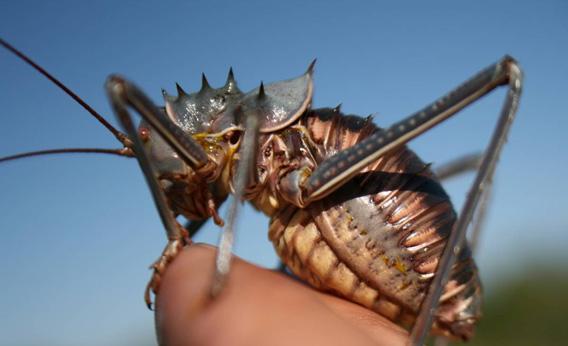 The downside of ground crickets is their repellence makes it hard to appreciate the brilliance of the species? adaptions
The downside of ground crickets is their repellence makes it hard to appreciate the brilliance of the species? adaptions Photo by Philip Bateman
It?s time. Time for their glittering armor and their orgiastic cannibalism, their rhythmically gyrating jazz-antennas and their fearsomely acrobatic, get-Hugh-Hefner-his-smelling-salts sex. Time for the stinking green blood they squeeze from their joints, and the weaponized vomit they smear over their bodies.
What it?s time for, as autumn approaches in the Kalahari, is the armored ground cricket. Never heard of it? That?s hardly surprising. These little lookers haven?t generally made the A-list of African wildlife at which generations of Roosevelts and Hemingways have aimed their elephant guns and Leicas. But if armored ground crickets face some rather formidable marketing challenges, they?re also ridiculously, absurdly fascinating.
Like many visitors to southern Africa, my three fellow road-trippers and I first ran across these crickets literally. As in, with a car. Crunch. Well?crunch?more than one. Crunch, crunch. Woops. Crunch. Watch it there, little fellas! Crunch crunch crunch crunch crunch. All this before we?d left the parking lot of a lodge south of Windhoek (the capital of Namibia, a country that despite any recently amplified cricket-related anxieties should be at the top of every African travel itinerary).
We pulled onto the open road and this drumbeat of crunching death accelerated to a blood-curdling, Jiffy-Pop pace. Utterly revolted, we pulled over almost immediately and turned off the ignition. Wandering into the silence of the windswept highway, we came face-to-spiny-face with our victims: fat, bristling with eponymous armor, and about two inches long, plus antennas.
Hideously mangled by an earlier car, one cricket?let?s call him, oh, Chester, shall we??struggled mightily, and with much antenna-waving, to right himself. We paused for a moment of obligatory liberal-arts-grad reflection on the trail of casual destruction that even the best-intentioned among us will leave in the world. Meanwhile, other crickets ambled over and stood in a somber arc around the grievously wounded Chester. Heads bowed, jazz antennas momentarily subdued, they seemed?somehow?to share the somber moment. Then they all, simultaneously, began to eat Chester alive.
Our shock and their meal were interrupted by the appearance of that rare Namibian beast?another car. We jumped aside and watched this vehicle flatten what remained of Chester and everyone else at his family-style dinner party. Soon, more crickets clambered over to feast on the dead and the undead-but-too-injured-to-flee. What we were watching was the genesis of a cricket pancake?a continually growing road-pie of ?spikes and spines and waving legs in a welter of gooey blood,? as Bill Bateman describes it. Bateman is a behavioral ecologist at the University of Pretoria in South Africa who, though he?s studied rhinos, hyenas, and kangaroos, keeps a special place in his heart for ground crickets. He first encountered ?their long solemn faces and gently waving antennae? as he watched them rip a beetle to pieces on a South African dune. ?I fell in love immediately.?
The cricket road pies, which spread like oil patches across Namibia?s highways, result not just from the crickets? penchant for roadside dining but from their extraordinary numbers. Park yourself on a chair outside, wait a few minutes, look over your shoulder, and you?ll likely see an armored ground cricket climbing steadily toward your neck to give you a friendly antenna-tickle. Walking isn?t any safer (not least for the crickets). Every 10th step you take will end with a sickening crunch underfoot.
The downside of ground crickets?aside from blood- and antenna-caked Reeboks?is that their general repellence makes it hard to appreciate the brilliance of the species? adaptions. (There are actually a number of species, and we apparently saw the flagship model, Acanthoplus discoidalis.) But in fact it?s their vividly noxious behavior that makes them so interesting to scientists.
Take the cannibalism. We never saw the crickets eat anything but one another. Nor did we ever see anything eat crickets, except other crickets. This, we joked, was perfection: the biological equivalent of a perpetual motion machine.
But crickets do eat other things, such as flowers and wild grasses. They also eat baby birds, although sometimes they just eat the bills off. And crickets eat crops, particularly the sorghum and millet that are staples of southern African diets.
When the cricket population peaks and food runs out, the crickets start to swarm?a group march in search of fairer pastures. The crickets are desperately seeking protein and salt. When you?re walking a lot?these crickets can?t fly?you?re going to get the munchies, and what?s saltier, more protein-filled, or more convenient than a nearby colleague? The ethos of the swarm, according to Bateman, is that of the French Foreign Legion: ?marche ou cr?ve? (march or die). Each cricket?s hind legs are ?literally being nipped at from behind.? If you?re not on the move, you?re on the menu.
Source: http://feeds.slate.com/click.phdo?i=963d0aa1f78875373c8e5ff53f9c3a1e
Zayn Malik miss america 2013 Oscar Nominations oscars ABC Family social security social security
No comments:
Post a Comment
Note: Only a member of this blog may post a comment.